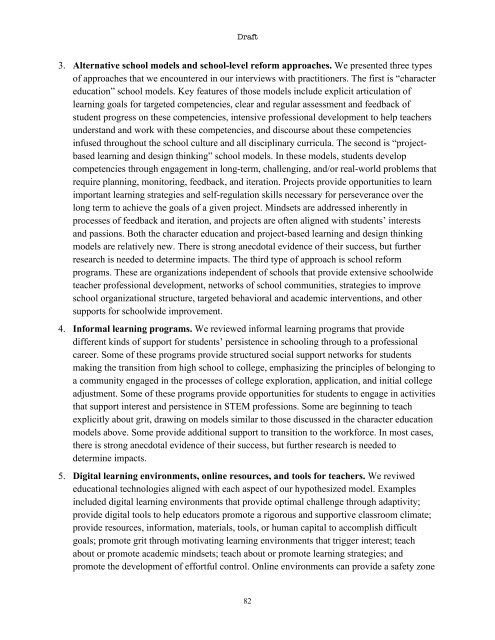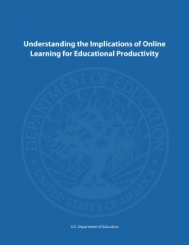Promoting Grit, Tenacity, and Perseverance - U.S. Department of ...
Promoting Grit, Tenacity, and Perseverance - U.S. Department of ...
Promoting Grit, Tenacity, and Perseverance - U.S. Department of ...
You also want an ePaper? Increase the reach of your titles
YUMPU automatically turns print PDFs into web optimized ePapers that Google loves.
Draft<br />
3. Alternative school models <strong>and</strong> school-level reform approaches. We presented three types<br />
<strong>of</strong> approaches that we encountered in our interviews with practitioners. The first is “character<br />
education” school models. Key features <strong>of</strong> those models include explicit articulation <strong>of</strong><br />
learning goals for targeted competencies, clear <strong>and</strong> regular assessment <strong>and</strong> feedback <strong>of</strong><br />
student progress on these competencies, intensive pr<strong>of</strong>essional development to help teachers<br />
underst<strong>and</strong> <strong>and</strong> work with these competencies, <strong>and</strong> discourse about these competencies<br />
infused throughout the school culture <strong>and</strong> all disciplinary curricula. The second is “projectbased<br />
learning <strong>and</strong> design thinking” school models. In these models, students develop<br />
competencies through engagement in long-term, challenging, <strong>and</strong>/or real-world problems that<br />
require planning, monitoring, feedback, <strong>and</strong> iteration. Projects provide opportunities to learn<br />
important learning strategies <strong>and</strong> self-regulation skills necessary for perseverance over the<br />
long term to achieve the goals <strong>of</strong> a given project. Mindsets are addressed inherently in<br />
processes <strong>of</strong> feedback <strong>and</strong> iteration, <strong>and</strong> projects are <strong>of</strong>ten aligned with students’ interests<br />
<strong>and</strong> passions. Both the character education <strong>and</strong> project-based learning <strong>and</strong> design thinking<br />
models are relatively new. There is strong anecdotal evidence <strong>of</strong> their success, but further<br />
research is needed to determine impacts. The third type <strong>of</strong> approach is school reform<br />
programs. These are organizations independent <strong>of</strong> schools that provide extensive schoolwide<br />
teacher pr<strong>of</strong>essional development, networks <strong>of</strong> school communities, strategies to improve<br />
school organizational structure, targeted behavioral <strong>and</strong> academic interventions, <strong>and</strong> other<br />
supports for schoolwide improvement.<br />
4. Informal learning programs. We reviewed informal learning programs that provide<br />
different kinds <strong>of</strong> support for students’ persistence in schooling through to a pr<strong>of</strong>essional<br />
career. Some <strong>of</strong> these programs provide structured social support networks for students<br />
making the transition from high school to college, emphasizing the principles <strong>of</strong> belonging to<br />
a community engaged in the processes <strong>of</strong> college exploration, application, <strong>and</strong> initial college<br />
adjustment. Some <strong>of</strong> these programs provide opportunities for students to engage in activities<br />
that support interest <strong>and</strong> persistence in STEM pr<strong>of</strong>essions. Some are beginning to teach<br />
explicitly about grit, drawing on models similar to those discussed in the character education<br />
models above. Some provide additional support to transition to the workforce. In most cases,<br />
there is strong anecdotal evidence <strong>of</strong> their success, but further research is needed to<br />
determine impacts.<br />
5. Digital learning environments, online resources, <strong>and</strong> tools for teachers. We reviwed<br />
educational technologies aligned with each aspect <strong>of</strong> our hypothesized model. Examples<br />
included digital learning environments that provide optimal challenge through adaptivity;<br />
provide digital tools to help educators promote a rigorous <strong>and</strong> supportive classroom climate;<br />
provide resources, information, materials, tools, or human capital to accomplish difficult<br />
goals; promote grit through motivating learning environments that trigger interest; teach<br />
about or promote academic mindsets; teach about or promote learning strategies; <strong>and</strong><br />
promote the development <strong>of</strong> effortful control. Online environments can provide a safety zone<br />
82
















